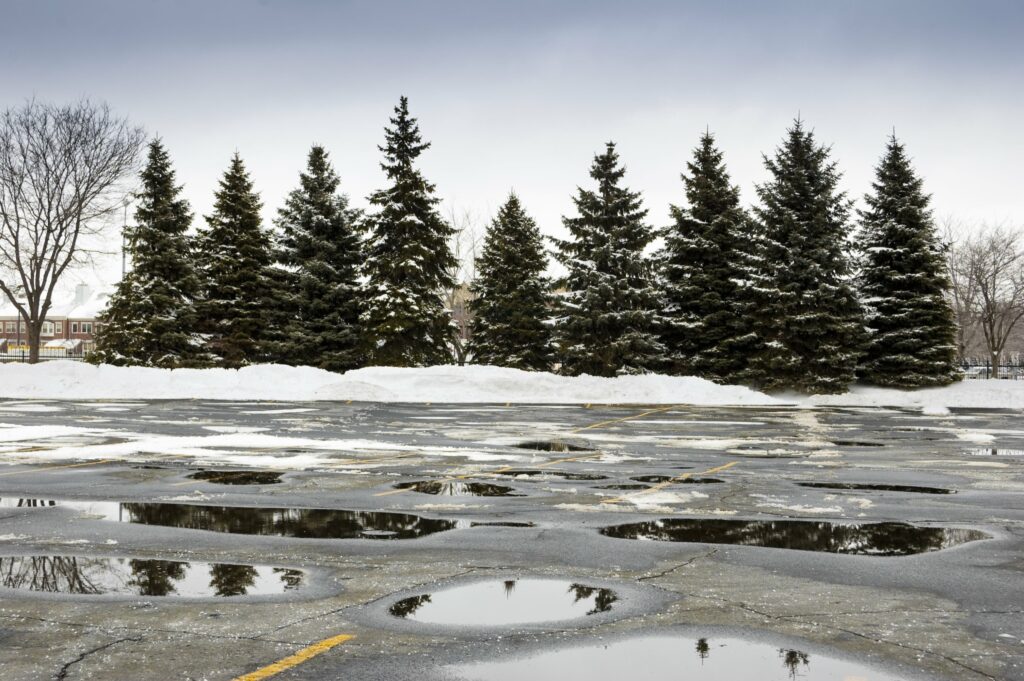You may think that concrete is impervious to the elements of nature, but it’s not. Winter weather conditions can wreak havoc on your pavement, causing cracks, discolored spots, and buckled joints. As a result, taking precautionary steps to maintain its longevity is crucial to ensuring your concrete lasts this winter and beyond.
Even the toughest concrete can show signs of deterioration, especially when exposed to freezing temperatures and snowstorms. Fortunately, you still have time to stop the seasonal cycle of damage and protect your concrete from the damaging freeze-thaw cycle of winter.
In this article, we’ll discuss the importance of maintaining concrete, the effect that winter weather can have on it, and some of the most effective methods for protecting concrete surfaces before the harsh winter weather arrives.
Continue reading below to learn about some of the best concrete care tips to keep concrete surfaces safe all winter long and why MegaKC is the number one team to trust when you need winter concrete maintenance services in Kansas City you can count on.

The Importance of Preparing Your Concrete for Winter
Concrete is one of the most widely used and long-lasting man-made materials, offering numerous advantages. Although it provides superior strength and sturdiness, environmental elements can cause concrete to require repairs for various reasons.
Despite its supreme durability, concrete can sustain structural or physical damage caused by expansion and contraction during extreme temperatures, resulting in cracks and unsettled concrete surfaces. Furthermore, daily freeze-thaw cycles can occur in many climates where the temperature falls below freezing at night and rises above freezing during the daytime, making concrete more vulnerable to significant damage.
Freeze-thaw damage occurs when moisture, whether from rain, snow, ice, or water vapor, causes concrete to deteriorate. When water comes into contact with unsealed concrete, it seeps into the various pores of the concrete, as well as any cracks. When temperatures drop, the water trapped inside the concrete will freeze and expand, causing discoloration of the concrete and hairline cracks, surface scaling, and joint corrosion.
When the warmer months arrive, the water inside the concrete melts away, revealing tiny cracks in the structure’s surface layer. When the tiny cracks are filled with water again the following winter and the temperature drops, the water expands, making more room for itself and causing more distress in the concrete surface. The constant freezing and thawing cause the tiny cracks to grow larger over time, and if not maintained or repaired, the surface will become permanently damaged.
If you’re considering adding concrete installations to your business, you should consider the possibility of winter damage, as low-quality or improperly prepared concrete can be more susceptible to the damage caused by freezing and thawing.
Fortunately, there are many actionable steps you can take to minimize the effects of the freeze-thaw cycle and keep your concrete in good condition.
3 Steps to Protect Concrete from Winter Weather
Winter can be especially difficult on commercial concrete surfaces. During the cold winter months, the damage to the concrete increases as the structural integrity is put under pressure due to freezing temperatures. Fortunately, planning ahead can save you money on potential business interruptions and liability claims.
Here are three easy steps you can take to keep your concrete surfaces free of winter weather damage and help you save money on expensive repairs in the future:
Apply Sealant to Concrete Surfaces
While concrete is an incredibly sturdy material, it’s also very porous. As a result, it’s absorbent to water, which can decrease its longevity.
To repel moisture and resist stains, concrete should be sealed and re-sealed regularly with a protective sealant. The frequency with which you must re-seal your concrete is determined by factors such as weather and vehicle/foot traffic. Most experts recommend applying concrete sealant every two years for acrylic-resin sealers, every three to five years for topical sealers, and every ten years for penetrating sealers.
Pouring water on the concrete can help you determine whether it needs to be re-sealed if you have a penetrating sealer. If the concrete absorbs the water or you notice cracks or peeling, it’s time to have the concrete re-sealed.
Use Concrete-Safe De-Icing Salts or Chemicals
Although salt appears to be a simple and effective way to remove ice from concrete, it can also damage concrete. Once the chemicals have melted through the ice and snow, they will penetrate the surface of your concrete. As a result, you must exercise extreme caution when choosing an ice melt for your concrete.
Deicing agents work by chemically lowering the freezing temperature of the water and converting snow and ice into a salty brine solution. Because this solution keeps thawing and refreezing as the weather and temperatures change, the concrete is subjected to far more freeze-thaw cycles than it would otherwise.
Choose natural, salt-free, and effective ice melt over chloride-based de-icer. The ingredients in safe paw ice melt are non-corrosive and free of chlorides and acetates. It also comes in an industrial-strength version with traction agents and has a modified crystalline amide core interlaced with glycol.
Patch and Repair Cracks and Other Surface Flaws
While walking on concrete surfaces, you might notice cracks or divots you haven’t seen before. These cracks make your concrete much more vulnerable to damage during the winter, when water can seep in and freeze, resulting in larger cracks and surface flaws.
Are any of your concrete surfaces beginning to deteriorate? If you notice any cracks or major flaws in your concrete surfaces, the best way to prevent further damage to the surrounding concrete is to patch and repair the cracks as soon as possible.
MegaKC is Kansas City’s Number One Choice for Winter Concrete Care
Understanding how to protect your concrete from winter damage is critical to ensuring the longevity of your investment and keeping it in the best condition possible. We hope this guide will help you better understand how to properly care for your concrete before winter arrives and extend the life of your concrete.
Are you looking for professional winter concrete maintenance to help repair any damage damaged by the cold weather?
At MegaKC, we’re dedicated to providing our Kansas City clients with superior concrete repair and maintenance services.
Our team has a reputation for producing high-quality work at reasonable prices, and we’re committed to providing our customers with solutions that reflect our commitment to precision and professional craftsmanship. With our commitment to quality and passion for making our local communities a better place to live, work, and play, we remain dedicated to ensuring that each job is done with the utmost care and precision.
To learn more about MegaKC and our winter concrete protection services, contact us today to speak with a team member about why we’re the number one choice for concrete repair services in Kansas City.


